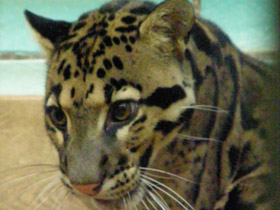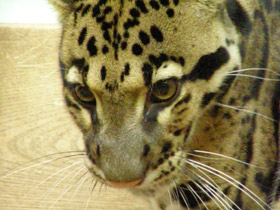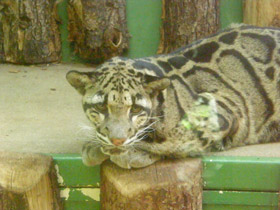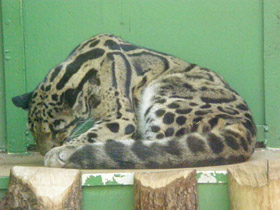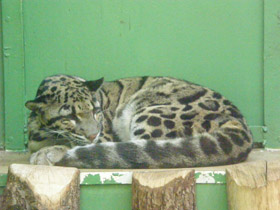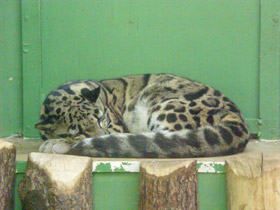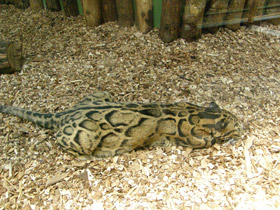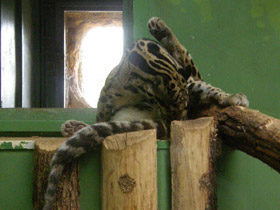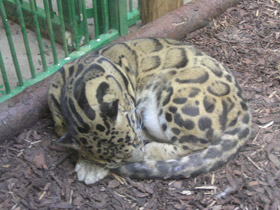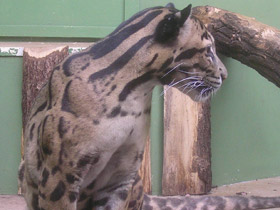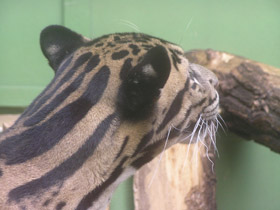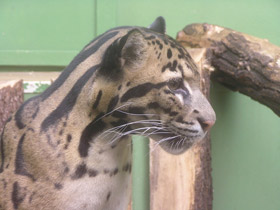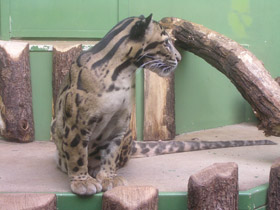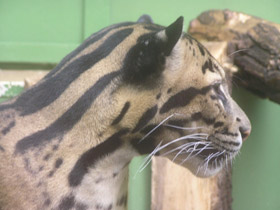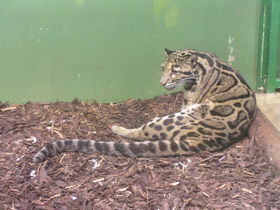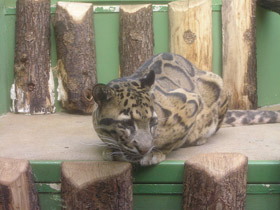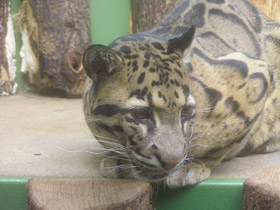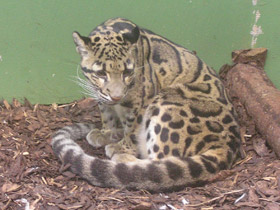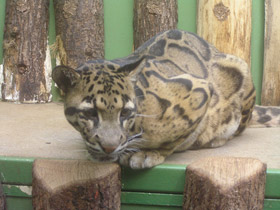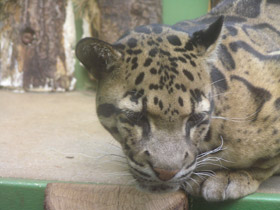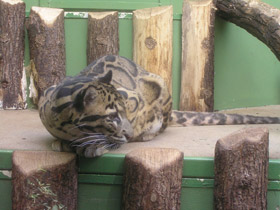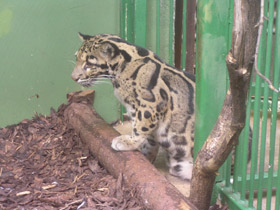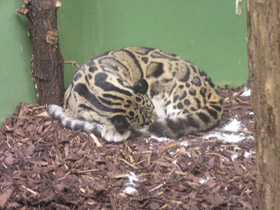The clouded leopard or mainland clouded leopard (Neofelis nebulosa)
The clouded leopard (Neofelis nebulosa), also called mainland clouded leopard, is a wild cat inhabiting dense forests from the foothills of the Himalayas through Northeast India and Bhutan to mainland Southeast Asia into South China.
Appearance
Neofelis nebulosa is one of two species of felids belonging to the genus Neofelis.
Contrary to its name, this predator is not directly related to true leopards. It is so morphologically and ecologically different from other felids that it is identified in a special genus, Neofelis, which means "new cat", occupying an intermediate position between small and big cats.
Neofelis nebulosa is closer to the big cats in terms of skull structure and teeth, but also has features that resemble small cats. For example, because its hyoid bone is fully ossified, Neofelis nebulosa is able to purr; its pupil is ovoid rather than round. The tusks of this beautiful predator are larger than those of other felids in proportion to body size; perhaps this adaptation allows it to hold prey trapped in trees (where it is more difficult to do so than on the ground). Its long canines (up to 4.5 cm) also help it to easily kill its prey with a single bite. This is also facilitated by the wide spacing between the canines and premolars, which allows Neofelis nebulosa to make very large and deep bites.
The jaws of Neofelis nebulosa can open wider than those of any other cat. This animal is quite large in size: body length is 70-106 cm, not including the 90 cm long tail (60-90 cm), weight is 16-25 kg.
Interestingly, males of Neofelis nebulosa can be more than twice as large as females, which is the largest size difference between the sexes in felines. The body of Neofelis nebulosa is elongated, flexible, and the legs are short, with broad paws and bare, stiff calluses, useful for climbing trees.
Coarse greyish or yellowish coat with a splendid pattern of broad, narrow stripes in the form of circles, rosettes and ovals, in which the rear edges are much sharper than the front ones, which further enhances its colouring.
Habitat and lifestyle
Neofelis nebulosa is distributed in southern Asia from Nepal, Sikkim, southern China (including Hainan and Taiwan) south to Sumatra and Kalimantan. It is a typical inhabitant of dense tropical forests, partly thickets and swamps, at altitudes up to 2,500 metres above sea level. Neofelis nebulosa spends most of its time in the trees, its long tail helping it to maintain its balance.
This predator is perfectly adapted to the arboreal lifestyle: it has a low centre of gravity, large legs with sharp claws for grasping, a long tail for balance; and the bony structure of its wrist and flexible ankle joints allow Neofelis nebulosa to cling to a moving trunk or branch in much the same way as a squirrel does.
Observations have shown that Neofelis nebulosa can move along horizontal branches, hanging upside down like a sloth; it is even able to hang on to branches with its belly, holding on to them only with its hind legs. It sometimes leaps on its prey from branches overhanging the ground, but often hunts directly on the ground.
Neofelis nebulosa is largely specialised in bird predation, but in addition to birds it also attacks monkeys, pigs, deer, goats, porcupines, baby buffalo and reptiles. It can hunt both day and night, tracking its game on the ground or catching it by leaping from a tree. In Sumatra, Neofelis nebulosa, which inhabits areas close to human habitation, is extremely cautious and therefore leads an exclusively nocturnal lifestyle. Neofelis nebulosa has good binocular vision and can see in semi-darkness six times better than humans. Neofelis nebulosa swims well, crossing large expanses of water and finding isolated islets, so it may have populated small islets from Vietnam to the island of Borneo.
Reproduction
Pregnancy in Neofelis nebulosa lasts between 86 and 92 days. Kittens (usually 2, occasionally up to 5) are usually born in the hollow of a tree; newborn pups weigh between 150 and 280 grams and develop relatively slowly. The eyes of the hatchlings open on day 10-12. At birth they are covered with a yellowish-grey coat, but in the first 6 months they develop adult spots. At 10 and a half weeks, the kittens move on to adult food, but continue to receive mother's milk for 5 months. At 9 months, Neofelis nebulosa are independent of their mother and can lead a life of their own.
Hunting and diet
When hunting, the clouded leopard stalks its prey or waits for the prey to approach. After making and feeding on a kill, it usually retreats into trees to digest and rest. Its prey includes both arboreal and terrestrial vertebrates. Pocock presumed that it is adapted for preying upon herbivorous mammals of considerable bulk because of its powerful build, long canines and the deep penetration of its bites. In Thailand, clouded leopards have been observed preying on southern pig-tailed macaque (Macaca nemestrina), Indian hog deer (Axis porcinus), Bengal slow loris (Nycticebus bengalensis), Asiatic brush-tailed porcupine (Atherurus macrourus), Malayan pangolin (Manis javanica) and Berdmore's ground squirrel (Menetes berdmorei). Known prey species in China include barking deer (Muntiacus sp.) and pheasants. In northern Peninsular Malaysia, a male clouded leopard was photographed while carrying a binturong (Arctictis binturong) in its jaws.
Taxonomy and phylogeny
Felis nebulosa was proposed by Edward Griffith in 1821 who first described a skin of a clouded leopard that was brought alive from Guangdong in China to the menagerie at Exeter Exchange in London. Felis macrosceloides proposed by Brian Houghton Hodgson in 1841 was a clouded leopard specimen from Nepal. Felis brachyura proposed by Robert Swinhoe in 1862 was a clouded leopard skin from Taiwan. The generic name Neofelis was proposed by John Edward Gray in 1867 who subordinated all three to this genus. At present, N. nebulosa is considered a monotypic species due to lack of evidence for subspeciation.
Felis diardi proposed by Georges Cuvier in 1823 was based on a clouded leopard skin from Java. It was considered a clouded leopard subspecies by Reginald Innes Pocock in 1917. In 2006, it was identified as a distinct Neofelis species, the Sunda clouded leopard. Populations in Taiwan and Hainan Island are considered to belong to the mainland clouded leopard.
Subespecies
- Neofelis nebulosa brachyura;
- Neofelis nebulosa macrosceloides;
- Neofelis nebulosa nebulosa.
Conservation
The clouded leopard is listed in CITES Appendix I and protected over most of its range. Hunting is banned in Bangladesh, China, India, Malaysia, Myanmar, Nepal, Taiwan, Thailand and Vietnam. It is not legally protected outside Bhutan's protected areas. Hunting is regulated in Laos. No information about its protection status is available from Cambodia. These bans, however, are poorly enforced in India, Malaysia and Thailand.
In the United States, the clouded leopard is listed as endangered under the Endangered Species Act, prohibiting trade in live animals or body parts.
International Clouded Leopard Day is celebrated each year on 4 August since 2018 in zoos and conservation organizations all over the world.
In captivity
Clouded leopards have been kept in zoos since the early 20th century. The international studbook was initiated in the 1970s. Coordinated breeding programs were started in the 1980s and encompass the European Endangered Species Programme, the Species Survival Plan, and the Indian Conservation Breeding Programme. As of 2014, 64 institutions keep clouded leopards, including six zoos in India:
- The zoo in Sipahijola Wildlife Sanctuary since 1996;
- Darjeeling Zoo since 1996;
- Aizawl Zoo since 2006;
- Itanagar Zoo since 2009;
- Gangtok Zoo since 2010;
- Shillong Zoo since 2012.

















